Time-sheet Submission (Via Web Access)
All AAO employees are required to submit a weekly time-sheet . This is essential to the organization as it allows us to plan our work better and to correctly charge projects
. This is essential to the organization as it allows us to plan our work better and to correctly charge projects  . The time-sheet period is Monday to Sunday.
Time-sheets must be submitted every Monday following the period concerned
. The time-sheet period is Monday to Sunday.
Time-sheets must be submitted every Monday following the period concerned  . If you are on leave or otherwise not at work on the Monday, then you must submit them on the first available opportunity after that point
. If you are on leave or otherwise not at work on the Monday, then you must submit them on the first available opportunity after that point  . If you are going on extended leave, submit your time-sheets for all periods covered by the leave on the day before you go on leave
. If you are going on extended leave, submit your time-sheets for all periods covered by the leave on the day before you go on leave  .
Here is the Business Portal Web page link
.
Here is the Business Portal Web page linkTime-sheet System Introduction
To enter your time-sheet you must access a certain web-page on our Business Portal web site. You can create a new time-sheet or edit a previously saved time-sheet that has not yet been submitted. You add lines to the time-sheet detailing the tasks (project or otherwise) you have been working on - or indicate you have been on leave. You specify the hours for each task. You can then save the time-sheet for later completion or submit it. Your supervisor is notified when you submit a time-sheet and is required to check that it makes sense. If they reject it they will talk to your or send you an e-mail message indicating why. You must then return to the time-sheet web page and fix the problem. The process below seems complicated, and it is somewhat more complicated then we would like. But you will quickly learn the process and become efficient at it. (Consider that an order )
)
Accessing the Business Portal.
Due to being part of our Microsoft Dynamics (Solomon) system - timesheet submission must be done via the Business Portal web site. This is, unfortunately, very much Microsoft centric and You must use Internet Explorer (windows only) to make it work . (We were sold this system on the basis that it did not require IE
. (We were sold this system on the basis that it did not require IE  .) But there are schemes which mean you don't need a windows machine as your main machine
.) But there are schemes which mean you don't need a windows machine as your main machine  .
In addition - you need to be logged in on the AAO Domain - this is a scheme which allows you to use the one user name and password throughout AAO machines. The domain is
.
In addition - you need to be logged in on the AAO Domain - this is a scheme which allows you to use the one user name and password throughout AAO machines. The domain is aao-domain and under this scheme you may need to specify your username as aao-domain\<username> rather then just plain <username>. There will be a password associated with this domain login (at some point to become your main AAO password through both Windows and Unix systems).
External Users
If you are outside the AAO, then you must first connect via the AAO VPN before you can access the business portal. This means that services will not be available to users with simple web access only.Fully Set-up AAO Windows Users - logged in on the Domain.
If you use a MS Windows machine as your normal machine and have logged into the AAO domain, then you should need only to start IE and goto this pageOther Windows Users (not logged into the domain).
Goto this pageaao-domain\<username> rather then just plain <username>. (For example aao-domain\tjf rather then tjf).
You may at this point be asked to install "Microsoft Business Framework" with the following dialog.
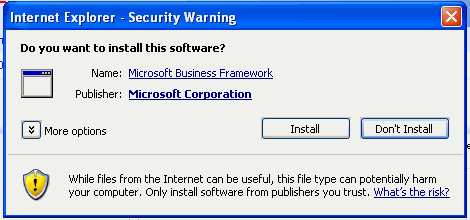 Please confirm you are viewing the right page and then select "Install". (If you don't have permission to do this install, please ask your machine administrator).
You may also have to add "businessportal" to your list of trusted sites - IE will tell you it has blocked the site but offer you the ability to add this site.
Please confirm you are viewing the right page and then select "Install". (If you don't have permission to do this install, please ask your machine administrator).
You may also have to add "businessportal" to your list of trusted sites - IE will tell you it has blocked the site but offer you the ability to add this site.
Mac and Linux Users 
I'm afraid that you are forced to use Remote Desktop to log into a "terminal-services" MS Windows machine in order to submit your timesheet. You will need to log into the machine "termsrv1" (192.231.167.203)
Mac Users
The Microsoft version of Remote Desktop seems to work somewhat better then the X11 version. If you have Microsoft Office 2004 installed on your mac, then you will find this in/Applications/Microsoft Office 2004/Additional Tools/Remote Desktop Connection
Otherwise, goto the The Micro$oft Mac siteaao-domain.
If you get the login prompt without explict mention of the domain, specify aao-domain\<username>, as your username, where <username> is your usernas
Now, in the remote desktop MS Windows session, you should start IE and goto this pageLinux Users.
If not already installed on your machine, an open source version of Remote Desktop is available from Sourceforgerdesktop -d aao-domain -u tjf 192.231.167.203Where "-u" is specifying your domain username,
tjf in this case.
Run rdesktop without any arguments to see the full list of options.
Now in the remote desktop MS Windows session, you should start IE and goto this pageOther Windows Users via Remote desktop.
You might want to use Remote Desktop to connect from windows in some cases (say to use a different user name from what you are logged in as on the domain). This program is found inStart->Programs->Accessories->Communications->Remote Desktop ConnectionWhen you start the program you will be prompted for the name of the machine to connect to - which is "termsrv1" (192.231.167.203). I suggest you explore the "Options" and, in particular, save a configuration that will automatically connect to the machine. Also remember to specify the Domain as
aao-domain.
If you get the login prompt without explict mention of the domain, specify aao-domain\<username>, as your username, where <username> is your username.
Now in the remote desktop MS Windows session, you should start IE and goto this pageBusiness portal - getting to the time-sheet.
At this point you are likely to see a screen roughly like the following one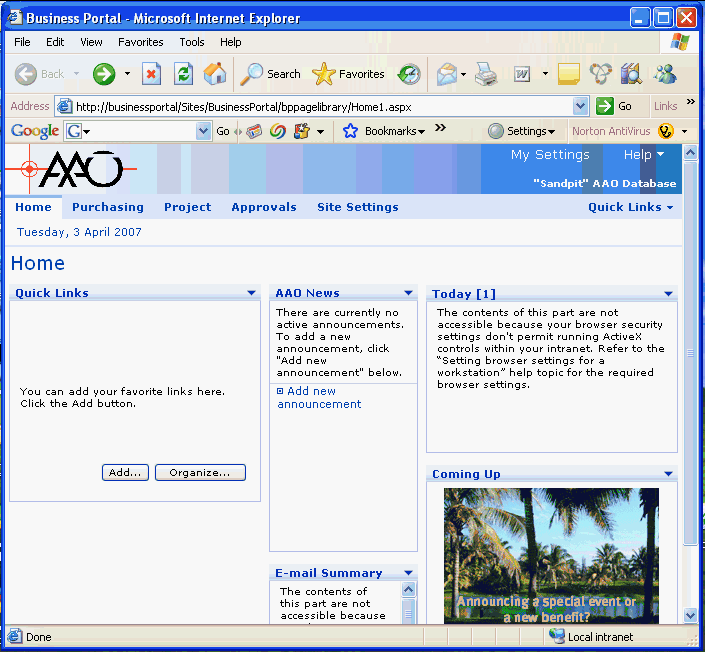 Please select the Project button in the top line of links.
You should now see a page with a link named "Time" down the left hand side. Select that link. This should give you a page like this one
Please select the Project button in the top line of links.
You should now see a page with a link named "Time" down the left hand side. Select that link. This should give you a page like this one 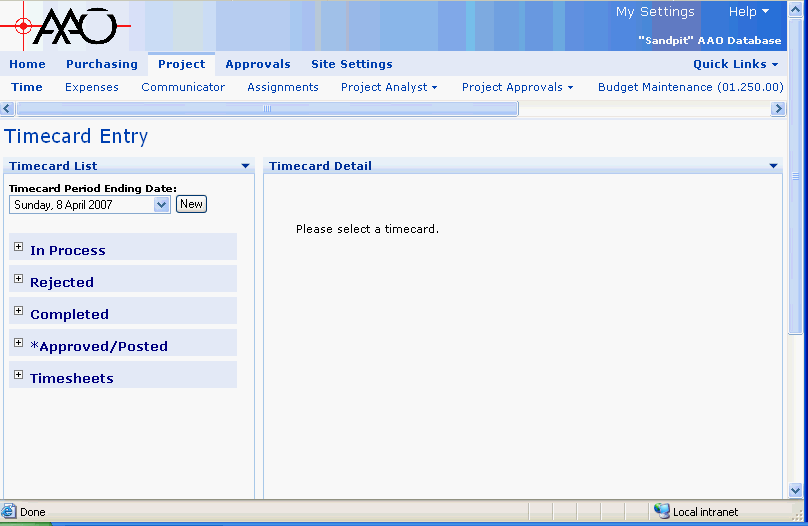 Down the left hand side are the following links/buttons
Down the left hand side are the following links/buttons - New button
- Invoke this button to create a new time-sheet for the period ending date specified with the drop-down list.
- In Progress
- Expand this to see a list of time-sheets you have started but not yet submitted.
- Rejected
- Expand this to see a list of time-sheets that have been rejected.
- Completed
- Expand this to see a list of time-sheets you have submitted but which have not yet been approved.
- Approved/Posted
- Expand this to see a list of time-sheets that have been approved.
- Timesheets
- DONT KNOW YET - Check
Time-sheet layout.
The timesheet will appear to the right of the window - here is a typical layout: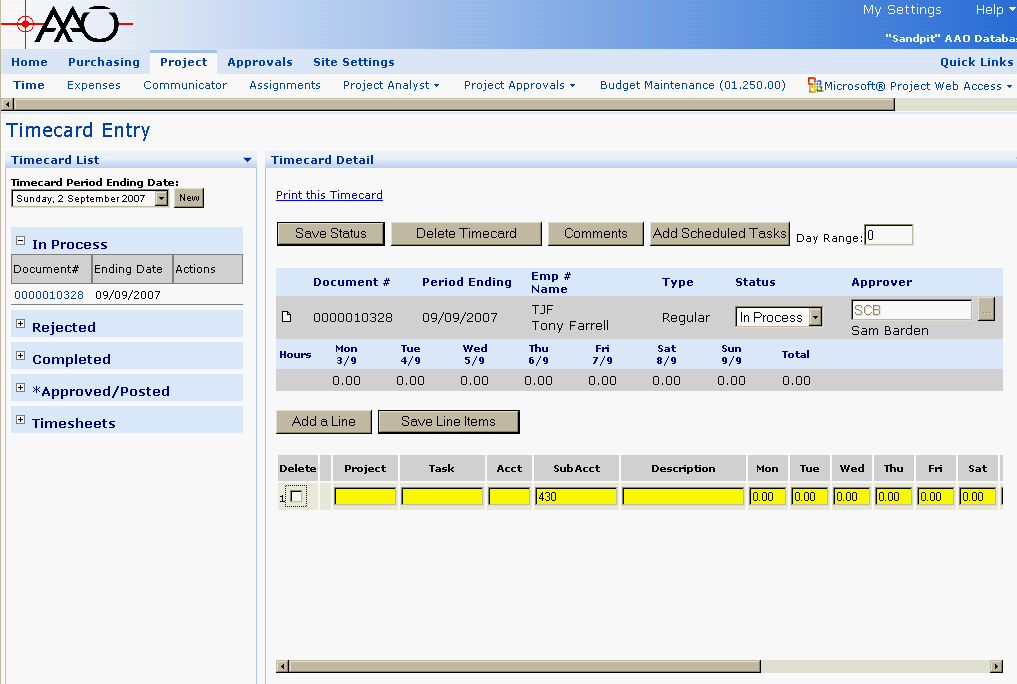 The following image labels each significant item in the time-sheet area of the screen
The following image labels each significant item in the time-sheet area of the screen 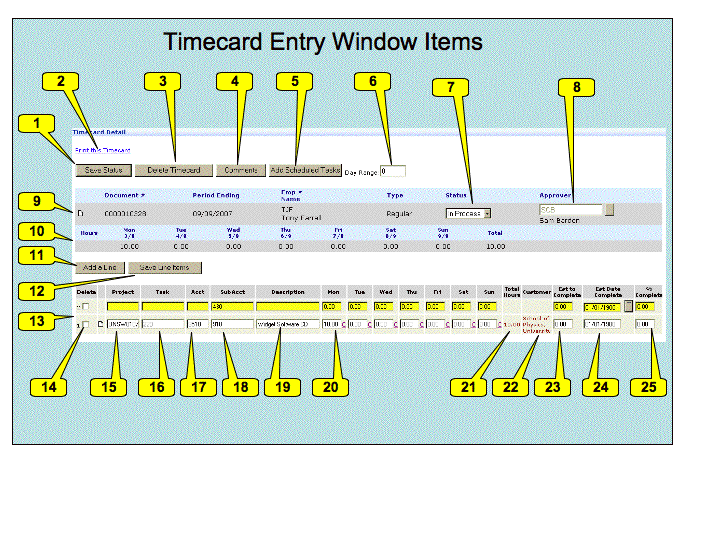 Here are the descriptions of each labeled item.
Here are the descriptions of each labeled item.
- The Save Status button - invoke to save the current status of the timesheet.
- The Print this Timecard link - invoke to produce a printable version of the timecard in a new window.
- The Delete Timecard button - invoke to delete this timecard without submitting it (only if status is In Process or Rejected)
- The Comments button - invoke to add comments to be saved with your timecard - typically comments for your supervisor (time-sheet approver).
- The Add Scheduled Tasks button - invoke to add a line to your time-sheet for every task which you currently scheduled to be doing.
- The Day Range entry - when adding schedule tasks, include for this day range (Details still needed - check
 )
)
- The initials of the person who approves you time-sheet will appear here. SCB (Sam Barden) in this example.
- The Status of this time-sheet. Whilst you are working on it, you should set this to
In Process. To submit this time-sheet, set this toCompleted. This value may also beRejectedif your time-sheet has been rejected - you can set it back toCompletewhen you have corrected it. The status may also beApproved/Postedwhen your time-sheet has been accepted. - Information on this time-sheet appears here. The "Document #" is a unique system ID number - you can ignore it. The period ending and employee details are then specified, as is the type of Time-sheet (don't know what that means - check).
- This line shows the total time you have booked for each day in the period, and the total for the period.
- The Add a Line button - allows you to add a new line to the time-sheet. You must add a line for each separate thing you have worked on, and for each type of leave.
- The Save Line Items button - allows you to save the current set of lines (difference between this and "Save Status" - check
 )
)
- The OT1 and OT2 check-boxes - to be selected before adding a line if that item is for overtime work. Details TBD
 .
.
- The detail lines - initially these lines does not exist. Using the Add a line button or the Add Scheduled Tasks button will add lines of this style. When your timesheet is complete you should have one of these lines for each task you have worked on during the period and for each type of leave you have taken (if any) during the period - except for flex leave, don't book that at all.
- The Delete checkbox - if this is selected when you invoke the "Save Line Items" button, then the specified line is deleted.
- The Project entry box - the Solomon ID of the project this line refers to must go here. If you double click this box, you will see a list of projects. The Description field will give you the information you need to select the right project. Just click on the relevant row to select the project.
- The Task entry box - the Solomon ID of the project task this line refers to must go here. If you double click this box, you will see a list of tasks. The Description field will give you the information you need to select the right project. Just click on the relevant row to select the task.
- The LabClass entry box - should be filled in automatically. You can ignore this.
- The Acct entry box - should be filled in automatically. You can ignore this.
- The SubAcc entry box - should be filled in automatically. You can ignore this.
- The Billable checkbox - should be filled in automatically. You can ignore this.
- The Description entry box - Optional. Add any extra information you wish to provide about this item.
- The hours entry boxes - enter the number of hours worked on this task per day (decimal hours). Alternatively, you can book all hours to one day.
- The Total Hours item - off the screen to the right in the picture. The total number of hours you have entered for the task.
- The Est to Complete item - off the screen to the right in the picture. Enter the number of hours to complete the task in this box.
Filling in a Time-sheet
To fill in a timesheet, you should first Invoke "Add Scheduled Tasks" to add automatically the list of all tasks you are scheduled to do within the period. If you have not actually worked on one of these tasks you can use the "Delete" check-button to remove it. You can linger the mouse over the Project and Task fields to see a description of the project and task. For each other task you have done or for each type of leave taken, you should use the "Add a Line" button to add a new line. (
Leave types and Other AAO Work
Here is the set of leave tasks available:| Solomon task description | comments |
|---|---|
| Annual Leave | |
| Sick Leave | |
| Public Holiday | Please book 7.35 hours for these |
| Personal Leave | AKA Special leave |
| Long Service Leave | Please book 7.35 hours per nominal day for these |
| Solomon task description | Work Details |
|---|---|
| General Admin | Booking of time sheets, Attendance at approved general non-project meetings called by AAO management, All management activities not associated with project planned activities not included elsewhere, Time spent travelling associated with G&A activities" |
| Training - technical | Time spent on official training programs for technical reasons but non project specific, Time spent on official training programs for administrative reasons but non project specific" |
| Scientific and tech meetings | Attendance at discretionary scientific meetings supported by the AAO, Attendance at discretionary technical meetings supported by the AAO, Attend trade shows" |
| OH&S | Time on OH&S meetings and any associated AAO approved activities other than training, Time on OH&S AAO approved training including fire drills & associated training". NOT FOR OH&S Project time. |
| Business Development | Time spent on approved AAO Business Development activities – visiting other establishments to develop work opportunities or to gain any business related benefits required by the AAO. Time spent on any activity associated with gaining revenue for the AAO. Time spent on “community related” work. Time spent on travel associated with Business Development activities" |
| WG Housekeeping | Time spent on cleaning and tidying up the work spaces under direction from local management. Industry visits IT related activities associated with work group (back-up, purchasing etc) Support to other internal work groups including Administration group" |
| HR Development | Time spent on discussion and planning of activities and training and on receiving feedback on personal efficiency and development needs with supervisors - at the direction of local management. Reading technical publications, web and library search activities " |
| Student Supervision | Time spent supervising students |
| Building Maintenance | Time spent on infrastructure support for Epping and site facilities |
| Project Solomon | Time spent on implementation and training for the new management and financial software system, MS Dynamics SL |
| Other | Anything else - please detail in description field |
Page Security settings
These settings make this page visible by all.- Set ALLOWTOPICVIEW = AAOGeneralGroup, TWikiAdminGroup, TWikiGuest
| I | Attachment | History | Action | Size | Date | Who | Comment |
|---|---|---|---|---|---|---|---|
| |
TimecardEntryItems.gif | r2 r1 | manage | 81.3 K | 2007-04-03 - 03:04 | TonyFarrell | Image of power-point file - allocating numbers to time card entry |
| |
TimecardEntryItems.ppt | r1 | manage | 69.5 K | 2007-04-03 - 03:05 | TonyFarrell | Power point used to create TimecardEntryItems.gif |
| |
businessframeworkwarn.gif | r1 | manage | 9.8 K | 2007-04-02 - 22:36 | TonyFarrell | Microsoft Business Framework install message. |
| |
businessport-entry.gif | r1 | manage | 53.8 K | 2007-04-02 - 23:29 | TonyFarrell | Business Portal Entry page. |
| |
timecard-entry.gif | r1 | manage | 20.0 K | 2007-04-02 - 23:29 | TonyFarrell | Timecard Entry page. |
| |
timecard-initial.gif | r1 | manage | 46.3 K | 2007-04-03 - 00:28 | TonyFarrell | A Timecard |
This topic: BusinessPractices > WebHome > WorkInstructions > WebTimesheet
Topic revision: r3 - 2007-04-05 - TonyFarrell
Ideas, requests, problems regarding TWiki? Send feedback

